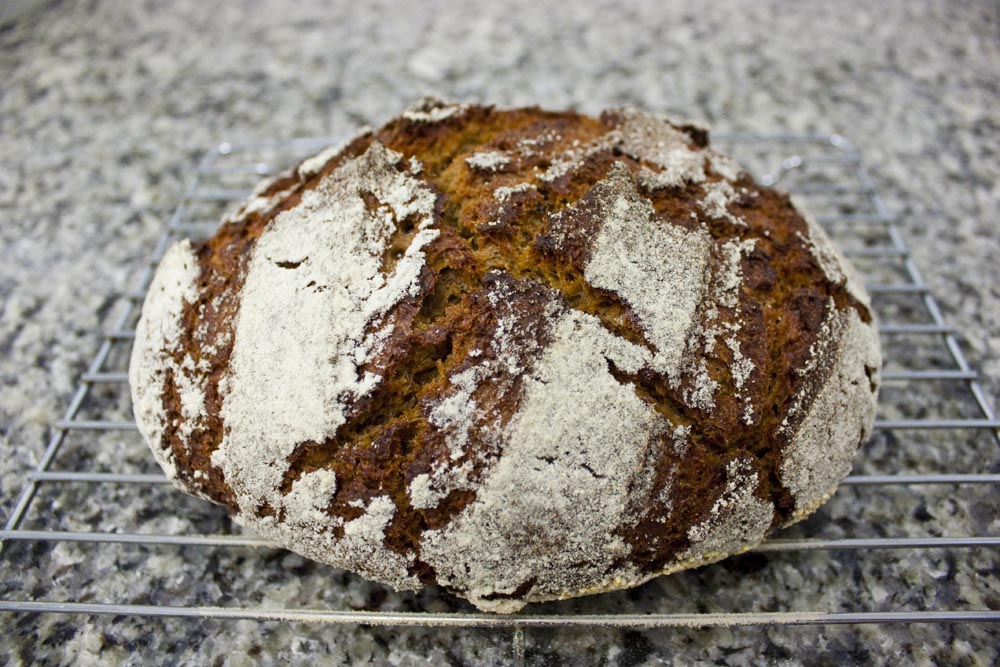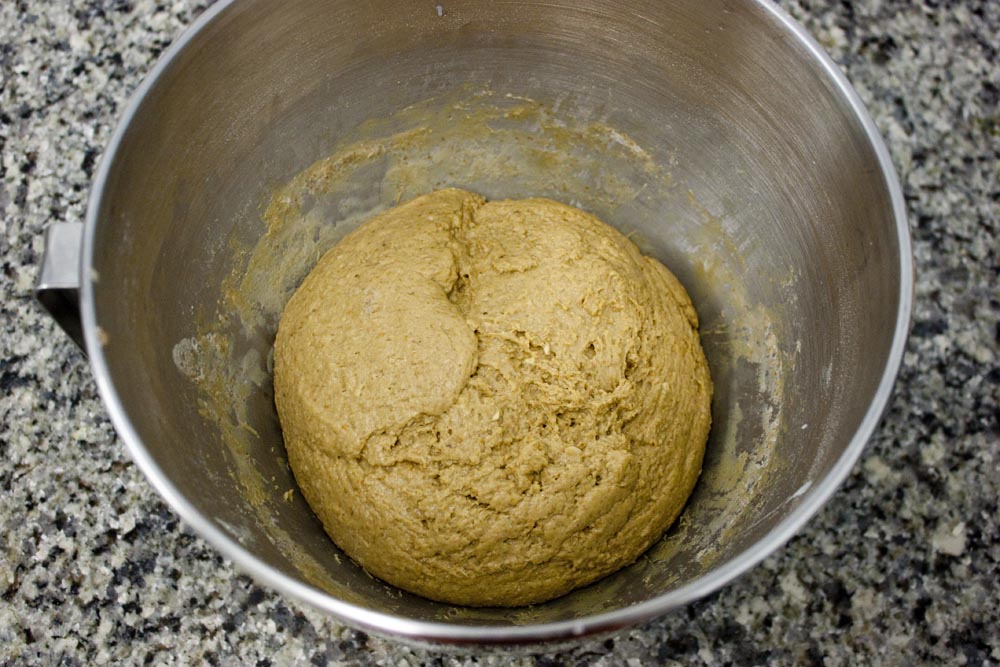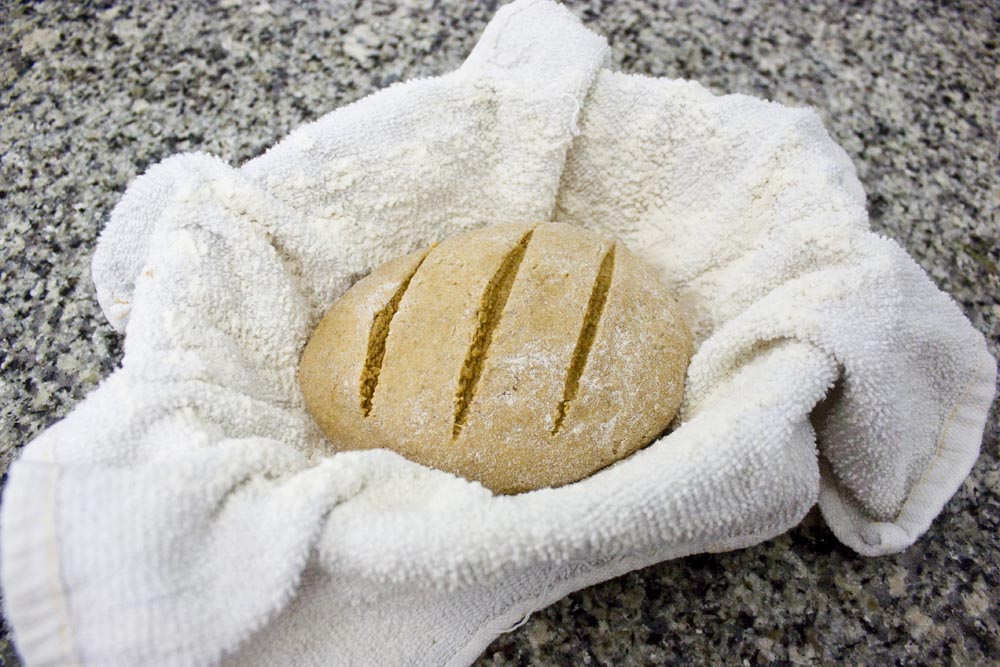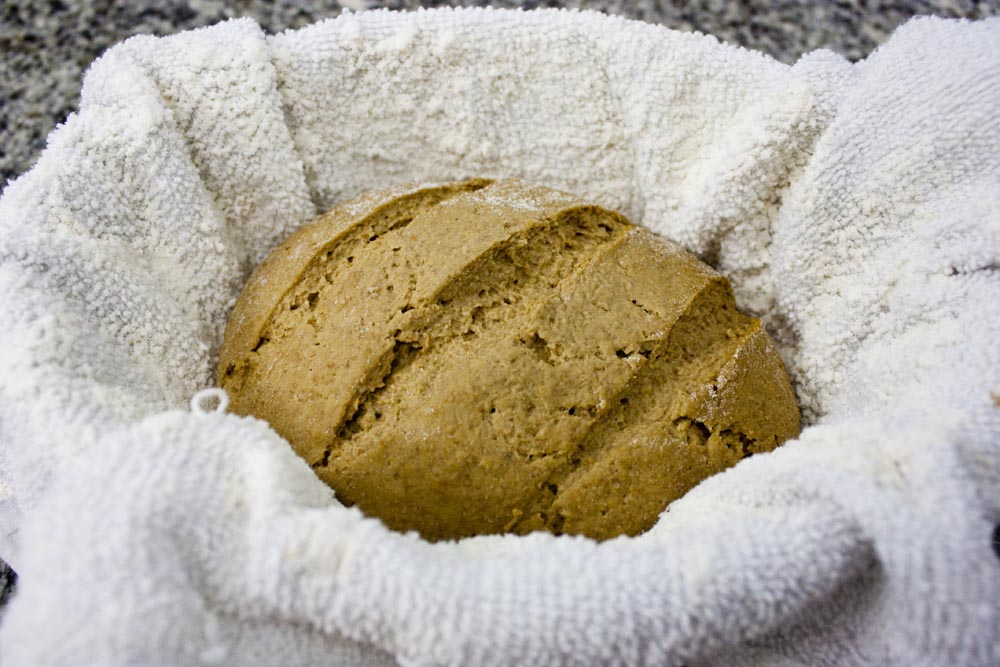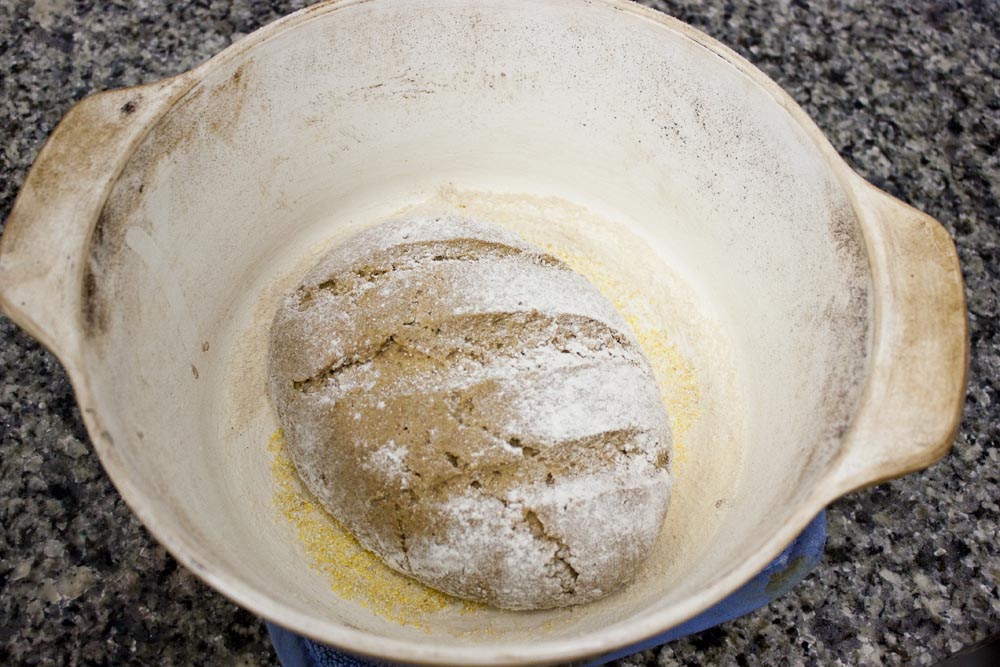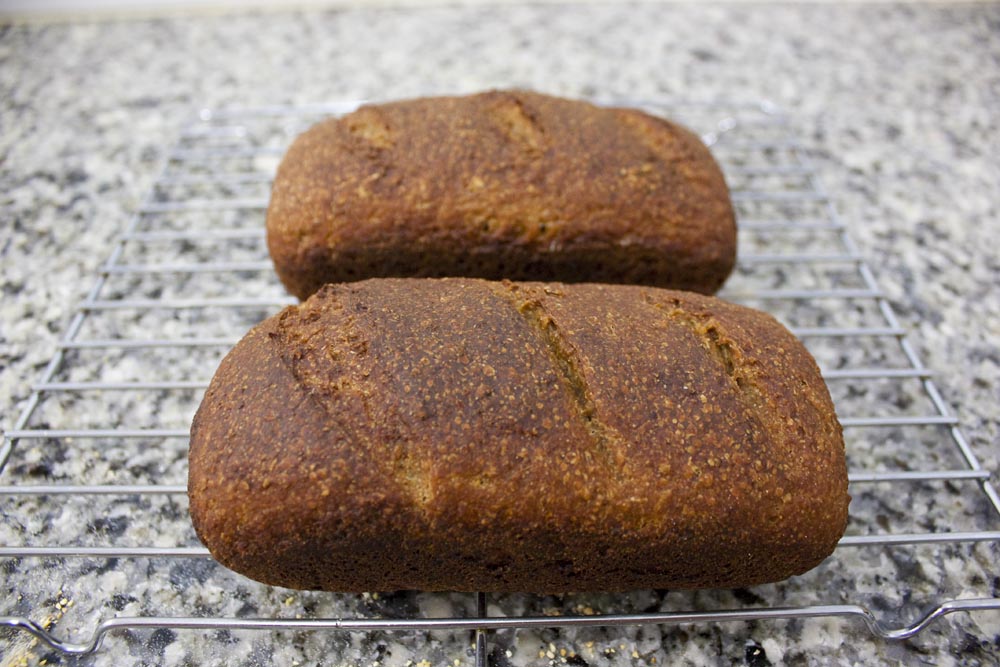About this recipe
This oat barley sourdough bread recipe is well fermented over a three day period. The sponge and bulk dough both get to spend a night in the refrigerator to slow and extend the fermentation time. This increases the sour flavor, the nutrition of the loaf and the evenness of the crumb. It also fits better into my schedule, since most of my available baking time is on the early and late ends of the day.
This recipe does not have enough gluten to hold a full crust together. It tends to blast the crust into smaller plates during the initial ten minutes of baking(oven “spring”). But it still forms a nice thick and crunchy crust over most of the loaf if baked inside a covered casserole or dutch oven.
My standard sourdough starter for the past year is made and maintained with 100% whole wheat bread flour and water. There are no other ingredients in the starter. It is the best starter I have ever used, very tangy and producing a consistently good rise with all of the grain combinations I have tried so far. I feed it equal amounts of 100% whole wheat bread flour and filtered water every morning without removing any existing starter as many recommend. This builds up a larger amount of starter which I rely on for the whole wheat component of my breads(no additional whole wheat flour added later in the recipe). It also results in a starter that has a large percentage of more heavily fermented grain.
Oat barley bread is a hearty loaf without being heavy or chewy. It satisfies. The high percentage of mixed whole grains provide a lost of flavor depth to back up the “tang” of the sourdough fermentation. The crumb is even and light without large “caves” of emptiness and it has just enough gluten to hold together well for sandwiches. This fermented bread will fit into any healthy whole food diet.
Ingredients
1 1/2 cups whole wheat sourdough starter 3/4 cups whole rolled oats
1 cup whole barley flour 1 1/2 cup unbleached wheat bread flour
1/2 cup filtered water 1/2 teaspoon sea salt
1/4 teaspoon freshly ground black pepper 1 tablespoon olive oil
1 tablespoon molasses 1/2 cup unsweetened plain yogurt cup
Preparation
A. Make the sponge
1. Place the starter, oats, water, 1/4 cup barley flour and 1/4 cup bread flour into a mixing bowl or stand mixer bowl and combine well with a dough hook or wooden spoon.
2. Cover the sponge with a towel or plastic wrap and leave at room temperature for two hours.
3. Place the covered sponge into the refrigerator overnight or up to 18 hours.
4. Remove the sponge from the refrigerator and allow to warm to room temperature, about two hours. The sponge should have visibly risen and show some air bubbles.
B. Make the bulk dough
1. Add the yogurt, salt, pepper, oil, molasses, 1/4 cup barley flour and 1/4 cup bread flour to the sponge. Mix well.
2. Continue to add 1/4 cup of flour, alternating barley and bread flours, mixing very well after each addition, until a stiff dough is formed. The dough should start to climb up the dough hook or pull away from the sides of the mixing bowl. There should be a little bread flour left but this depends on how wet the starter was and the room humidity. Continue to knead or mix for another four to five minutes.
3. Cover the bulk dough and leave at room temperature for two hours.
4. Place the covered bulk dough into the refrigerator overnight or up to 18 hours.
5. Remove the bulk dough from the refrigerator and allow to warm to room temperature, about two hours. The bulk dough should be doubled in size. Leave at room temperature, covered, until it has doubled in size.
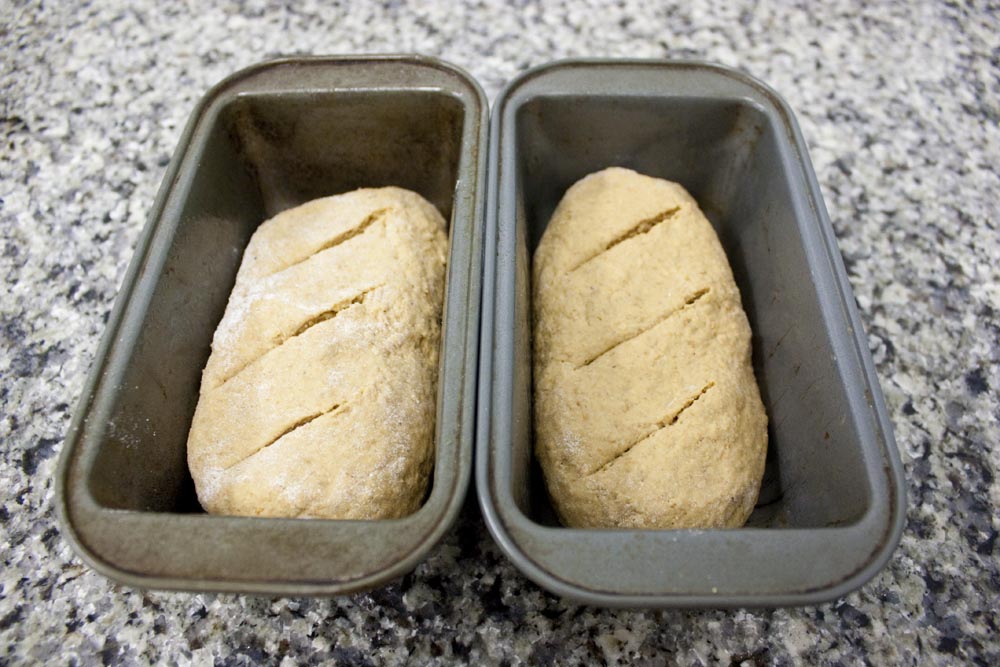
Two mini loaves formed from the second half of the risen bulk dough. These will be used for finger sandwiches and to serve with red chile stew.
C. Form the loaf or loaves
1. Sprinkle flour over the risen bulk dough and on a flat, smooth work area. Turn the bulk dough out of its container onto the work area.
2. Knead the dough for four to five minutes, using as much more bread flour as needed to prevent the dough from sticking to the work surface or hands.
3. Form the dough into the loaf or loaves for baking. This recipe makes enough dough for a 2-pound loaf. I like rustic loaves best and use loaf pans only when I need sandwich bread with a soft crust. If using a loaf pan, pace the shaped dough into a lightly oiled pan, slit the top, cover as before and allow to rise until doubled in size. If making a rustic loaf, place into a basket lined with a well-floured towel, slit the top, cover as before and allow to rise until doubled.
4. Rising will usually take 4-5 hours. If you will not be able to bake at that time, immediately refrigerate the loaf and plan to remove 1 1/2-2 hours before baking.
D. Bake the loaf
1. For a rustic loaf with a thick, crisp, chewy crust preheat a ceramic casserole or dutch oven with a fitted lid to 450-degrees. Remove from the oven, remove the lid, sprinkle coarse corn meal over the bottom and turn the risen loaf into the casserole. Replace the lid, return to the oven and bake for 20-25 minutes. Remove the lid, reduce heat to 375-degrees and bake until done, another 15-20 minutes.
2. For a sandwich loaf, place the risen dough in the loaf pan into a pre-heated 400-degree oven for 25-30 minutes. Check, reduce heat to 350-degrees and finish baking, another 15-20 minutes.
3. remove the loaf immediately from the casserole or loaf pan and place on a cooling rack at room temperature. Allow to cool through, about one hour, before cutting the loaf.
Notes
Sourdough bread will last much longer than bread made with commercial yeast. To maintain the crispness of the crust, store leftover bread in a brown paper bag of bread box for up to 3-4 days, slicing as needed. This bread will last 5-6 days in a sealed plastic bag but the crust will get soft. Always slice only what will be eaten immediately and leave the rest of the loaf intact for maximum shelf life.
A rustic loaf can be baked on a sheet if you do not have a covered casserole or dutch oven of the right size. The crust will not be as crisp or as thick as when baked in a covered casserole, even if a container of water is added to the oven during baking. For an intentionally soft crust, brush with melted butter or olive oil after the first 15 minutes of baking time. For a shiny crust, brush with egg yolk and water twice during baking.
This recipe can easily be made vegan by replacing the yogurt with water, almond milk or another liquid of your choice. The whole grains used in this oat barley sourdough bread contribute to whole food health.

